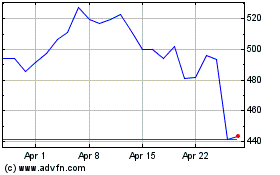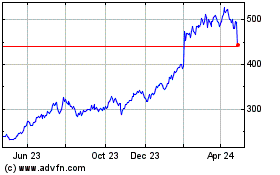By Resty Woro Yuniar in Jakarta and Liza Lin in Singapore
In Southeast Asia, Instagram is more than just a place to share
photos. The Facebook Inc.-owned platform is where people go to
shop.
Social media sites from Facebook to Naver Corp.'s Line are
luring consumers by using messaging as a tool and launching new
shopping features, rapidly expanding into e-commerce in a region of
620 million people, which includes Indonesia and Thailand.
Their success has been propelled by millions of small to medium
enterprises, growing smartphone penetration, and a fragmented
e-commerce landscape where the region lacks a dominant player like
Amazon.com Inc.
About 30% of online sales in Southeast Asia--a region with 150
million digital consumers--were done through social networks in
2016, estimates consultancy firm Bain & Co. That compares with
just 7% of the roughly 287 million internet users that are likely
to buy from social networks in the U.S., according to London-based
market research firm GlobalWebIndex.
"This is an easy revenue opportunity," says Ferry Grijpink,
partner at consultancy firm McKinsey & Co.
Facebook and Line have launched shopping features to create new
revenue streams specifically for the Southeast Asian market. More
shoppers means more advertising dollars from businesses vying for
visibility for their products.
Consumers in Southeast Asia rely heavily on sales assistants for
advice and enjoy bargaining, behavior that is now playing out
through Facebook's Messenger platform, said Nadia Tan, head of its
small medium businesses unit in Southeast Asia. In Thailand, for
example, users send twice as many Facebook messages to businesses
each month than the global average, the company said.
On Tuesday, Facebook announced a special pack of stickers--large
emoticons displaying cute characters--for its Messenger service in
Thailand to cater to the growing social commerce trend there. The
first of its kind globally for the platform, the stickers are
designed to facilitate interactions between buyers and sellers on
the platform, and includes cartoons to match phrases like "your
order is ready" and "can I get a discount?"
This follows the rollout last year in Southeast Asia of a
section called Shop, which allows entrepreneurs who already run
business pages on Facebook to have their products prominently
displayed on its news feed. Facebook expanded Shop to other markets
this August.
Under Shop, consumers can view photos of products ranging from
T-shirts to sewing machines on Facebook, and then use Messenger to
discuss a sale, get directions to the physical stores or find a
link to purchase on their official website.
Facebook doesn't disclose how much revenue it gets from online
shopping on its site, but notes Thailand, Vietnam, Indonesia,
Malaysia and the Philippines are among the top 10 markets where
Shop is most heavily used. The Asia-Pacific region also recorded
the fastest growth in business advertising last year of 64%,
compared with 62% in the U.S., the company said.
Small-and-medium enterprises in Southeast Asia rely on social
media because it is the cheapest and most efficient way to generate
buzz for their products, as online marketplaces traditionally apply
transaction fees. Buyers typically discover products on Facebook or
Instagram, then reach out to the seller using messaging apps such
as Line or WhatsApp to find out more details and complete the
purchase in person.
For Bangkok-based caterer JQ Puumanung Seafood, relying solely
on Facebook to drum up business was a logical choice, thanks to its
low cost and popularity, says founder Sureerat Sripromkam. Ms.
Sripromkam created a Facebook page, circulated photos of the
grilled or steamed crab the restaurant prepared, and uploaded the
menu online.
"Facebook helped us start the business immediately," says Ms.
Sripromkam, 37, whose business now handles between 500 and 700
orders a day. She pays 1,000 baht (U.S.$ 28) each day for marketing
on Facebook.
Messaging company Line, owned by South Korea's Naver, introduced
a tool for small businesses in Southeast Asia called Line@. More
than two million SMEs in Thailand, Indonesia and Taiwan use it to
broadcast promotions and coupons to customers, and for a one-off
fee of $24 they can customize their Line@ handles. Potential buyers
then text the shops to complete a purchase. Line users can also
order groceries and food in Thailand, or book a taxi in
Indonesia.
Line declined to comment on revenue earned from these e-commerce
efforts.
Not all efforts by social media companies to expand in shopping
have succeeded. Twitter tested a "Buy Now" button in 2014 that
allows users to buy goods from retailers such as Best Buy. But due
to lack of enough interest among merchants and users, Twitter said
it scaled back its effort on the shopping button in May.
But the region may be the best option for social network
companies to tap demand given the time spent on chat and social
apps, which is significantly higher than the U.S., analysts
say.
When buying clothes for her children, Lakshmi Ayu Saphira in
Jakarta browses more than 200 small retailers who have shop fronts
on Instagram.
"I'm addicted to it," said the 31-year old mom, who often taps
the 'explore' feature to discover new brands. "I always open it
during my spare time at work."
(END) Dow Jones Newswires
December 06, 2016 06:41 ET (11:41 GMT)
Copyright (c) 2016 Dow Jones & Company, Inc.
Meta Platforms (NASDAQ:META)
Historical Stock Chart
From Mar 2024 to Apr 2024

Meta Platforms (NASDAQ:META)
Historical Stock Chart
From Apr 2023 to Apr 2024
